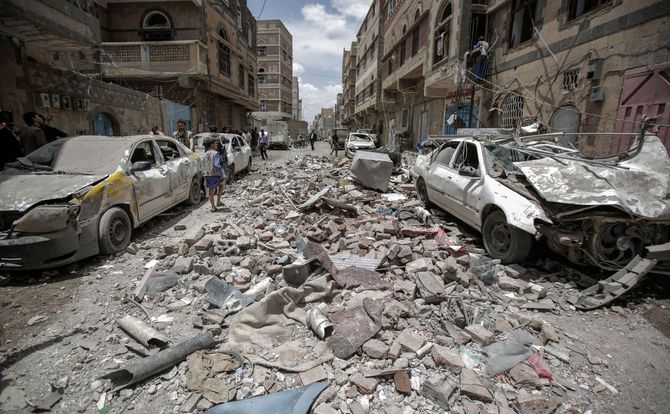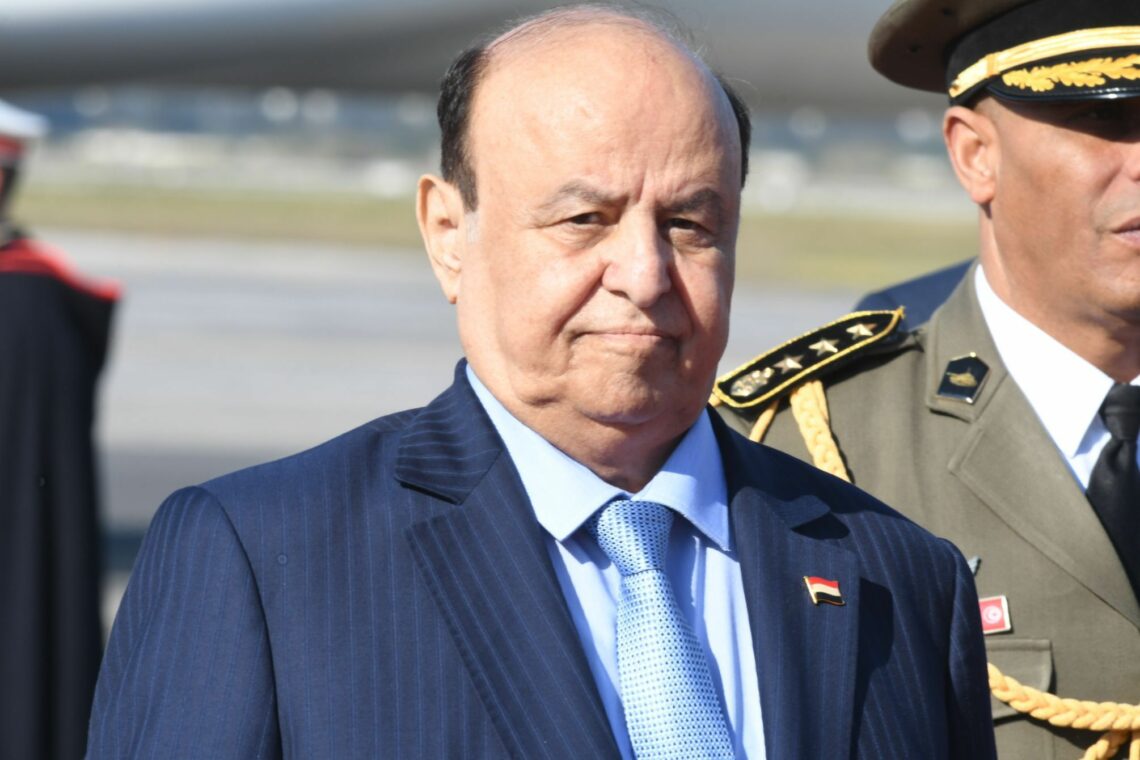Few prospects for an end to the war in Yemen
Iran and Saudi Arabia have taken advantage of a conflict fueled by regional and religious rivalries to fight a proxy war in Yemen. United Nations attempts to broker a cease-fire have failed, and everyday Yemenis are suffering. Both sides have powerful motives to keep the war going.

In a nutshell
- There are deep historical roots to the Yemen civil war
- Foreign powers have taken advantage of this for their own gain
- Attempts to reach peace have proven futile
- Regional powers have no intention of stopping the fighting
A civil war fueled by regional and religious rivalries is raging in Yemen, one of the world’s poorest countries. On one side is the Houthi minority backed by Iran, on the other the government backed by Saudi Arabia and its Arab coalition. Yemen has essentially become a battlefield in a proxy war – Iran against Saudi Arabia and the Gulf states – leading to one of the world’s worst humanitarian crises. The population is in urgent need of relief; a cholera outbreak which has already claimed many lives threatens to turn into a full-blown epidemic. Al-Qaeda and Islamic State (also known as ISIS or Daesh) are using the resulting chaos to develop and launch deadly terrorist attacks on both sides.
The United Nations’ attempts to broker a cease-fire after years of bloodshed have failed. No one has managed to find a political solution and stop the carnage. The Stockholm Agreement reached under UN auspices last December between the Houthis and the central government mainly deals with the creation of a secure zone in the port city of Hodeida for the delivery of humanitarian aid. The plan was poorly executed and has not led to the expected dialogue.
The roots of the conflict are embedded in the long history of the country, nearly the size of France, which at the beginning of the 20th century was still divided between the Ottoman-ruled north and the British-ruled south. The Houthis made up 50 percent of the northern population and belong to the Zaidi stream of Shia Islam. The Zaidis were the dominant religious group in the north for nearly 1,000 years. A secular military coup, backed by Egypt, overthrew the last Zaidi imam in 1962. The ensuing civil war lasted eight years.
Civil war
In 1990 North and South Yemen united to form the Republic of Yemen. Ali Abdullah Saleh, a Zaidi and president of North Yemen since 1978, became president of the new country. Zaidis represented only 35 percent of the new country’s population but remained the majority in the northern Saada governorate, parts of the west, and in the capital of Sanaa. Tensions soon developed with the central government, which the Zaidis accused of discrimination.
A cease-fire was achieved in 2010, but with the beginning of the Arab Spring in 2011, Houthis again protested against the regime.
One of their leaders, Hussein Badreddin al-Houthi, launched the Ansar Allah (defenders of Allah) movement to restore their former preeminence. Ensuing clashes with security forces escalated into open war. Al-Houthi was killed in 2004. His father took over, and later his brother, Abdul-Malik, who currently leads the group. Ansar Allah fighters, and all Zaidis, now call themselves Houthis, after these leaders.
A cease-fire was achieved in 2010, but with the beginning of the Arab Spring in 2011, Houthis again protested against the regime. Bowing to international pressure, President Saleh resigned and was replaced by Vice President Abd Rabbuh Mansur Hadi. As the sole candidate, he was formally elected in 2012. Nevertheless, the Houthis refused to acknowledge him, claiming he was pursuing the same discriminatory policies toward them. In the ensuing chaos, they took over the Saada region, bordering Saudi Arabia, and began pushing south. This is when Iran allegedly began aiding them. President Hadi attempted to reach a compromise, creating a “committee for national dialogue and the drafting of a new constitution.” However, it failed to satisfy the demands of all the parties.
Militants faithful to the ousted President Saleh joined forces with the Houthis in the fight against President Hadi’s army, until Mr. Saleh decided to defect. He was assassinated by the Houthis in December 2017.
Iran’s role
With its covert aid to the Houthi insurgency, Iran saw the conflict’s potential to undermine its rival, Saudi Arabia, and support the creation of a Shia crescent in the Middle East. The central government accused the rebels of not only abandoning their Zaidi heritage and getting closer to traditional Shia, but also of subverting republican principles and working to impose a religious regime.

Iran still denies that it is aiding the Houthis, though the facts show a different picture. It is now known that before the start of the rebellion Tehran was giving the Houthis $15-20 million a year, disguised as religious and cultural assistance. At first, the Houthis had neither sophisticated weapons nor the means to manufacture them. Iran then started supplying the Houthis with weapons and ammunition, later smuggling in missiles and drones, military advisors and raw materials for local manufacturing. Hezbollah’s Unit 3800, tasked with training terrorists outside of Lebanon, sent advisors to instruct Houthi fighters. Iran uses go-betweens and camouflage to continue supplying the Houthis. Saudi vessels and U.S. Navy ships patrolling the region have intercepted ships carrying Iranian weapons.
In 2014, fighting intensified and the Houthis took the capital, Sanaa. President Hadi was forced to resign and fled to Saudi Arabia. The following year, the Houthis took the port of Aden, which commands the entrance to the Bab el-Mandeb strait. They also took the cities of Taez and Hodeida, the latter of which hosts the largest port in the southern Red Sea and is the main hub for transporting goods to the rest of the country. The Houthis were now threatening shipping in the Red Sea, a conduit for a huge amount of international trade, including oil supplies. This development provoked great concern among countries along the coast, including Egypt, Israel, Jordan, Sudan and Djibouti. In March 2015, Saudi Arabia lent its support to the Yemeni government forces.
Saudi coalition
Saudi Arabia was now feeling the heat, surrounded by armed Iranian proxies such as Hezbollah and pro-Iranian Shia militias in Syria and Iraq. It assembled a coalition of seven other countries – the United Arab Emirates, Bahrain, Qatar, Egypt, Sudan, Jordan and Morocco – to defeat the Houthis and restore stability to Yemen.
A naval blockade was imposed on Yemeni ports and Saudi air raids targeted Houthi strongholds. A significant armed Emirati ground force was sent in, while Sudan and some other members dispatched token forces. Egypt took over patrolling the Red Sea to ensure free passage to the Suez Canal, but refrained from taking an active part in the fighting. Qatar was ousted from the coalition in 2017 as a result of the crisis with Saudi Arabia and its allies. Morocco left in 2019 following tensions with Saudi Arabia. Recently, Riyadh’s staunch ally, the UAE, has been reducing its troop numbers, perhaps fearing further deterioration of relations with Iran and wanting to reinforce its own defense.
The United States is giving the coalition logistical and intelligence support. It has also increased its arms sales. U.S. military activity in Yemen dates back to 2000, after the suicide attack carried out by al-Qaeda on the USS Cole while in the port of Aden. Seventeen sailors were killed and 39 injured. It has since maintained forces in Yemen to harass al-Qaeda cells in the southeast of the country, eliminating the leaders responsible for the Cole attack through a series of drone strikes.
The Houthis refused to implement the resolution – and the coalition continued its attacks against them.
The Jamal Khashoggi affair, as well as the deepening humanitarian crisis and the mass killing of civilians in Yemen, have led to heightened criticism of Saudi Arabia in the American media, and the U.S. Congress has expressed its displeasure with American intervention and arms sales to Riyadh and Abu Dhabi. It has twice passed bills requiring the president to obtain Congressional authorization prior to further action in Yemen. President Donald Trump has vetoed both, stating that the situation in Yemen presents a clear and present danger to American interests and those of its allies. In May 2019 he signed new arms sales in excess of $8 billion to Saudi Arabia and the UAE. The United Kingdom and France also sell arms to these countries, and also face increasingly vocal criticism in the media and from civic groups.
The Saudi-led coalition forces soon overtook Aden and most of the territories conquered by the Houthis in the southwest of the country but failed to retake Sanaa and the port of Hodeida. President Hadi hastened to return to Aden from Saudi Arabia where he had taken refuge, declared it a provisional capital, resumed his functions and asked the UN for help in redressing the country’s ills.
In April 2015, the UN Security Council passed Resolution 2216, providing for the use of force to implement its decisions. The resolution calls for an immediate halt to violence and demands that Houthis evacuate conquered territories, free the prisoners they hold and hand over weapons taken from various security forces. It also reasserted the embargo on the sale of weapons to the Houthis and their supporters. Lastly, it reaffirmed the legitimacy of President Hadi. Not surprisingly, the Houthis refused to implement the resolution, and the coalition continued its attacks against them. President Hadi returned to Saudi Arabia, where he remains to this day.
Humanitarian disaster
Low-grade warfare is still ongoing, with coalition forces mainly relying on airpower. They are not always effective, often hitting civilians and destroying government buildings. In the war-torn country, the humanitarian situation is dire. According to a February 2019 briefing to the UN Security Council by UN emergency relief coordinator Mark Lowcock, 80 percent of the population – some 24 million people – need humanitarian assistance. About 20 million require help in securing food or medical services. Half of that number is “just a step away from famine,” while more than 3 million people, including 2 million children, are acutely malnourished. Some 18 million lack clean water and access to sanitation. Both sides of the conflict show the same disregard for international law and the disastrous state of the economy. The UN did manage to bring relief to some 8 million people, but oppressive bureaucracy, attacks on aid workers and movement restrictions prevent assistance from reaching those who need it most.
Last June, the country teetered on the brink of an even greater humanitarian disaster. Houthi forces, frustrated by their inability to progress, intensified their launch of missiles and explosive-laden drones on oil installations and Saudi airports. In retaliation, the coalition decided to take the port at Hodeida, through which most Iranian military assistance is smuggled (despite the embargo).
A deep-seated lack of trust between the parties is the main stumbling block.
The UN and other relief organizations warned that an attack on the town would lead to a massacre of civilians, closing the port and stopping the transfer of food and humanitarian aid to the rest of the country. Even the U.S. opposed the move; Secretary of State Mike Pompeo called for a cease-fire and the U.S. Air Force stopped refueling coalition planes over Yemen. Saudi Arabia and the UAE hoped for a swift victory, cutting the Houthis off from the port, which also served as their home base. But they failed, unable to dislodge the Houthis from either town or port.
Intense pressure from UN special envoy for Yemen Martin Griffiths brought both sides to the negotiating table. At a meeting in Stockholm, they agreed on three points: 1) a cease-fire in Hodeida and the nearby ports of Salif and Ras Issa, as well as a redeployment of warring factions (this was supposed to include opening and securing a humanitarian corridor for the transfer of aid to desperate and starving populations); 2) establishing a process for the exchange of prisoners; and 3) supplying food to the people of Taez, after a three-year siege.
Unfortunately, these conditions were couched in ambiguous terms open to diverse interpretations. For the Houthis, “redeployment” did not mean withdrawing from Hodeida to the surrounding areas. Under strong UN pressure, the Houthis agreed to redeploy only around the two nearby ports. The rest of the agreement is not being implemented at all. A deep-seated lack of trust is the main stumbling block.
Open sore
Is there any hope for a political resolution? Judging from the Houthis’ determination to continue fighting, further negotiations seem far off. Iran, the Houthis’ main sponsor, will not willingly allow the war to end as long as its conflict with the U.S. remains unresolved and sanctions remain in place. It sees the fight against Saudi Arabia through its Houthi proxies as an important tool to pressure the West.
Do the Houthis still believe they can rule Yemen again, or at least establish an autonomous Zaidi zone? They have yet to declare their political demands, apart from an end to discrimination and participation in the government. These could be achieved through democratic elections, since they represent more than a third of the population and would have a decisive influence in parliament. Is Iranian influence so great that they have become its puppets at the expense of their own interests? The Stockholm Agreement will be the test. As long as it remains unimplemented, there will be no negotiations.
As to the Saudi-led coalition, in almost four years of fighting it has been unable to defeat the Houthis. It has been weakened by the war, but that will not stop its intervention. There is no light at the end of the tunnel for the suffering people of Yemen. Their country will remain a dangerous open sore, a pawn in the cynical war waged by Iran while the West dithers, refusing to act.






